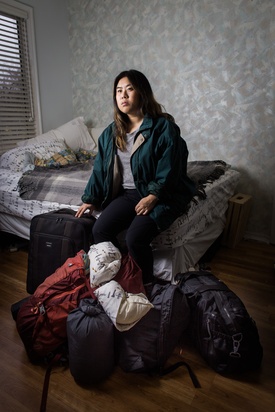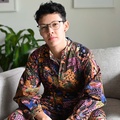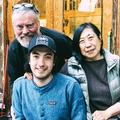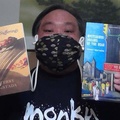“CALL FOR PARTICIPANTS: Seeking yonsei and gosei in Greater Vancouver and Victoria regions for a photo project in commemoration of the 30th anniversary of redress.”
When Kayla Isomura ran this notice in The Bulletin: a journal of Japanese Canadian community, history + culture and social media over the final few months of 2017 she couldn’t know what the success of the call-out would be. With a legacy of silence within the Japanese Canadian post-war community, there was no guarantee she woud receive much of a response at all. Thankfully, despite a slow initial uptake, she has ended up with a full shooting schedule, including both west coast Japanese Canadians and Japanese Americans from the Seattle area, one of the stipulations being that they live within driving distance of Vancouver.
The Suitcase Project asks Yonsei and Gosei (4th and 5th generation Japanese Canadians and Americans) what would they pack if uprooted from their homes with only a moment’s notice. Participants will be photographed in their homes and then interviewed about the items that they chose to pack.
The resulting exhibit will be on display at the Nikkei National Museum & Cultural Centre in Burnaby from June to September, 2018.
As Kayla prepares to start shooting at the end of January, she spoke to The Bulletin by email.
* * * * *
I’ve admired your photography for several years now, following you on Instagram, mainly. When did you first pick up a camera? And did you take to it right away? Do you have any formal training or are you self-taught?
Thank you, John! I am often asked how long I’ve been doing photography, and I usually never know how to respond.
Truthfully, I first picked up a camera when I was 12- or 13-years-old. I inherited a 4-megapixel camera from a great uncle and used it on school field trips for fun. It wasn’t until Grade 11 that I took a photography course in high school (also for fun). I learned the basic mechanics of shooting in film, developing in a darkroom and things like the rule of thirds. I took the class again the following year purely for fun, but I remember being a lot more interested in it in that senior year, experimenting with Photoshop and coloured film. I followed a few photographers online (Flickr at the time), but couldn’t emulate the work I was seeing because I was shooting in film or on a point and shoot camera. Silly, I know, but a lot of the work I was inspired by then were self-portraits shot on a 50mm f/1.8 lens.
The following year, I began studying journalism at Langara College, which is where my interest in photography really sparked. I used my journalism program as an excuse to buy a digital SLR. My dad bought me a second hand camera body, which was produced in 2006, that I still use today as a second camera. My time at Langara was spent with a lot of experimentation and practice with portraiture.
Later, I took a few lighting classes through Langara’s Continuing Studies program, which proved to be really valuable for what I want to do today. Since full-time photography school has never been in the picture, I think the primary way I’ve learned is simply shooting a lot, observing others and other work, and asking questions if anyone’s able to answer them.
The Suitcase Project is your first major photography project. What was the inspiration for the project?
While I was travelling for a few months around this time last year, I started to think about what I wanted to do when I came back to Vancouver. One of the biggest things was working on photography work I never had the chance to do. I’ve always been interested in a mix of work: fashion, editorial, and photojournalism.
I realized many of the photographers I follow on Facebook and Instagram create similar work, whether it’s the editing style or the type of models they shoot or even the locations. Everything is about looking good for “the ‘gram.” While I realized this type of work was doable (and very pretty), it wasn’t personal. It can easily be copied and reproduced, so what had more meaning to me? What would set me apart as a photographer when I think of what sets apart the artists I admire? I thought about how my own experiences could play a role in this.
Returning home, I somehow found myself thinking about internment and what would I pack if I was facing the same turn of events. Beyond me, I was very curious how others would respond. I applied for the National Association of Japanese Canadians’ (NAJC) Young Leaders Fund to help support the idea, and while I was waiting to hear back about the grant, I began mentioning the idea to folks. The initial response made me realize this was something I would do regardless of funding. Thankfully, I did receive some funding from the NAJC and upon my initial grant application, Sherri Kajiwara, Director/Curator of Nikkei National Museum, offered me space to exhibit it at the museum and the opportunity to work at the museum on my exhibit full-time.
Additionally, in 2016, I actually had an idea for an intergenerational photo project that never made it off the ground. At the time I was thinking about political and social issues that may differ from my time now to when my grandparents were my age, for example. Stemming from that, I think identity and my involvement in the Japanese Canadian community played a big role in developing The Suitcase Project and future works I have ideas for.
In hindsight, I think the moment Japanese Canadians and Americans were forcibly removed from their homes is significant. This moment every family faced was doubtfully captured by camera, but everyone had some form of choice to make. No one could predict the losses they would face during and after this time period. Had they known their remaining possessions would be sold or looted, how would they have packed differently? What people chose to pack also differed by age. I’ve learned of the many records teenagers packed at the time and how photo printing was in high demand shortly before families living in Vancouver were interned. We live in a digital age where all forms of entertainment and memories can be held in one device, but what if you had limited electricity, no access to the internet and were left to live in a shared shack in the middle of nowhere?
You’ve sent out notices calling for participants – what has the response been like?
The response has been enormous. I’ve had more than 90 individuals and families sign up, and the vast majority have been eligible to participate. Even on social media, I’ve read a few comments on different pages that have shared the call-out and they’ve been quite encouraging. While I’m only able to physically photograph folks within a certain driving distance of Vancouver, I’ve had people express interest from other cities across Canada and the States.
How did you decide who to include? Or did you take everyone who qualified?
The sole qualification I had was identifying as Yonsei or Gosei. I thought previously about specifying the connection to internment, but I assumed anyone who signed up would have a direct connection to it. After opening it up to Japanese Americans, I realized this wasn’t the case. I’ve had a handful of people sign up whose families weren’t interned, but faced other things. One person shared that their family was immediately forced to Japan and also went into hiding in the States. So yes, I’ve accepted everyone who met my one qualification. However, not everyone has expressed commitment yet, so I currently have 45 individuals and families I am expecting to photograph to date.
*This article was originally published on The Bulletin: a journal of Japanese Canadian community, history + culture on January 27, 2018.
© 2018 John Endo Greenaway / The Bulletin







